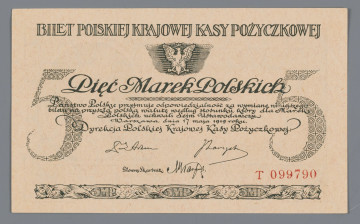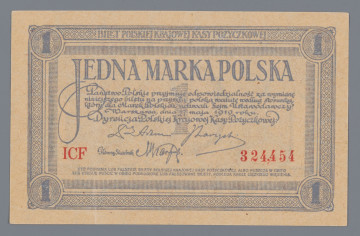
5 Polish marks
1919
National Museum in Lublin
Part of the collection: Paper money during the Second Polish Republic
The Polish state, reborn in 1918, undertook the uneasy task of rebuilding the country ruined by war and the effort to unite the lands that had functioned under the structures of the partitioned states. The challenge of the first months was to control the currency chaos caused by the variety of means of payment - above all the issues of the partitioning states. The unstable situation of the young state did not allow for the creation of the Bank of Poland and the national currency - the zloty. For a while, the function of a banking institution was taken over by the Polish National Loan Fund (PKKP), established by the Germans in 1916, and the Polish mark (mkp) became the temporary currency. It became the sole means of payment in the lands of the former partitions: German in November 1919, Austrian in March 1920 and Russian in July 1921. In December 1922, the German mark ceased to be valid in Upper Silesia. The occupational mkp was not cancelled after 11 November 1918 and functioned on the same principles as the independence issues. After the first pro-independence issue of 500 mkp in January 1919, which was modelled on the occupation banknotes, the subsequent issues were original works, breaking away from the established style.
The author of these beautiful banknotes with face values of 1, 5, 20, 100 and 1000 mkp was a leading Polish graphic artist Adam Jerzy Półtawski, the creator of the Polish typeface (Półtawski's antique). The aesthetics of the composition of these banknotes, the sophisticated choice of the typeface and the graphic motifs reflect the talent of the author of works in the field of illustration and book graphics, an award-winning creator of ex-libris and a distinguished teacher. On the reverse of the banknote at the bottom, on the sides of the decorative cartouche, are the author's initials: AP. Contrary to the signature, the portrait of the young man placed in an oval does not show Tadeusz Kościuszko, but most probably the Napoleonic adjutant Józef Antoni Kossakowski. The 20 mkp banknotes of 17 May 1919 were printed in the State Printing House in Vienna, and in Warsaw - in the Printing Works of Bolesław Wirtz and the PKKP Printing Works, where our copy was made.
At the time of its introduction to circulation on 25 September 1919, "Kurier Warszawski" offered gloves for 6 mkp, leather shoes for 250, an almost new double-barrelled shotgun for 2000, and a four-year-old horse for 8500. A dollar cost 35 mkp at the time.
Tomasz Markiewicz
Author / creator
Dimensions
cały obiekt: height: 145 mm, width: 92 mm
Object type
paper money
Technique
Material
paper
Creation time / dating
Creation / finding place
Owner
The National Museum in Lublin
Identification number
Location / status

1919
National Museum in Lublin

1919
National Museum in Lublin

1923
National Museum in Lublin
DISCOVER this TOPIC
Museum of King Jan III's Palace at Wilanów
DISCOVER this PATH
Educational path